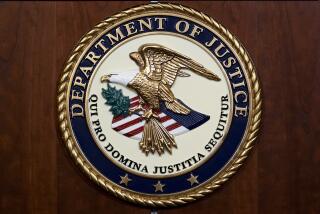Census Agrees to Count Asians as Group : Survey: If 1990 count is readjusted, category will separate them from Anglos.
Federal officials have agreed to create a separate category for Asians should a controversial statistical method be employed to readjust results of the 1990 Census.
Peter Bounpane, assistant Census Bureau director, said Friday that the bureau will modify its so-called post-enumeration survey, which previously grouped Asians with Anglos for the purpose of correcting undercounts of minorities and the poor in the 1990 Census.
The decision was hailed by Asian activists, who had lobbied for the change. But they warned that it would only have symbolic value unless census officials decide to use the survey results to adjust population figures. That decision is not expected until July 15, 1991.
Bounpane said census officials probably erred in not giving Asians a separate count in the proposed post-enumeration survey in the first place.
“It was bad foresight,” he said. “In retrospect, it would have been wise to do it for Asians.”
Previously, census officials ruled out a separate count, contending that any Asian undercount would not be detected because Asians constitute such a small percentage of the total U.S. population--about 3%, according to a 1985 estimate.
But after studying the matter more closely, officials said they found that Asian populations in six states--California, New York, Hawaii, Oregon, Washington and Alaska--are actually large enough to allow the bureau to measure any undercount of Asians.
Asians constitute 9.5% of California’s population, according to 1989 Department of Finance estimates. Blacks make up 7.5%, and Latinos 24.2%.
The Census Bureau decision will not require any more door-to-door interviews. Instead, it will force a change in the bureau’s method of computing information it already has compiled from 150,000 households participating in the post-enumeration survey nationwide. Those results are to be compared to completed census forms to see whether counting discrepancies emerge in various population groups. Asians have always had a separate category on the survey form, but originally were to be counted together with Anglos.
Now, however, separate counts will be taken of Asians and Pacific Islanders in urban areas of California, Hawaii, Oregon, Washington and Alaska, as well as in New York City, Bounpane said.
Reps. Norman Y. Mineta (D-San Jose) and Robert T. Matsui, (D-Sacramento) had joined local community leaders in accusing the Census Bureau of ignoring the Asian community at a time when immigrants from Taiwan, Hong Kong and Southeast Asia have swelled the population of urban areas.
An accurate count of Asians is crucial, they contend, especially since many immigrants may not have participated in the census because of language barriers or distrust of authorities. A 1986 post-census survey of East Los Angeles estimated that the 1980 Census significantly undercounted minorities: Almost 10% of the Latino community was missed, 7% of Asians and 9% of blacks.
“(This) means that the Census Bureau has finally recognized the importance of the Asian Pacific communities, and the damage that an undercount in these communities would do to California and the entire Pacific region,” Mineta said.
Now the battle shifts to the issue of whether the post-enumeration survey results will actually force corrections of the census. The decision rests with Secretary of Commerce Robert A. Mosbacher.
Los Angeles and other large municipalities are trying to force the bureau to use the survey results, claiming undercounts will deprive them of federal funds and congressional representation. Los Angeles officials believe the bureau’s early estimate of 3.42 million for the city is inaccurate.
More to Read
Sign up for Essential California
The most important California stories and recommendations in your inbox every morning.
You may occasionally receive promotional content from the Los Angeles Times.










